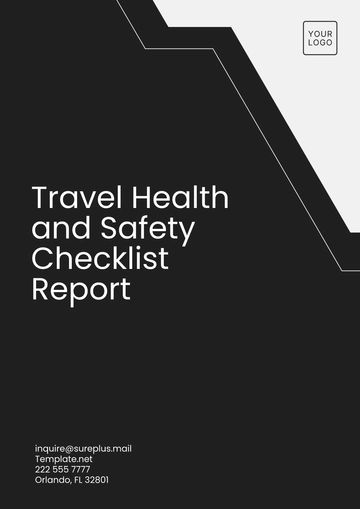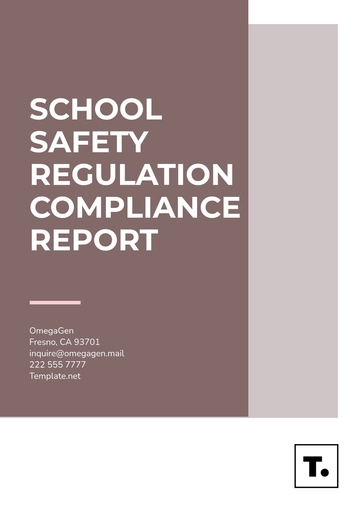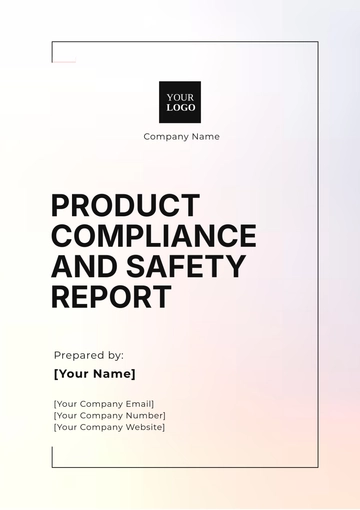Free Printable Monthly Health and Safety Report

Prepared by: [Your Name]
Company: [Your Company Name]
Date: October 29, 2050
1. Executive Summary
This report provides a comprehensive overview of health and safety performance for the month of October 2050. It highlights key performance metrics, identifies hazards, analyzes incident trends, and outlines recommended improvements to ensure a safe and healthy working environment for all employees. The findings reflect ongoing efforts to enhance workplace safety and ensure compliance with relevant safety regulations.
2. Introduction
The purpose of this monthly report is to evaluate the effectiveness of current health and safety measures, analyze reported incidents, and propose actions aimed at mitigating risks. The report serves as a critical tool for decision-makers to assess safety performance and make informed decisions regarding future initiatives. It also supports compliance with internal safety policies and external regulatory requirements.
3. Incident Reports
3.1 Summary of Incidents
Incident ID | Date | Type | Location | Status |
|---|---|---|---|---|
001 | 5 October 2050 | Slip and Fall | Warehouse | Resolved |
002 | 12 October 2050 | Equipment Malfunction | Assembly Line | Under Investigation |
003 | 20 October 2050 | Chemical Spill | Lab | Resolved |
3.2 Analysis of Incidents
Three incidents were reported during October 2050. While the total number of incidents remained consistent with previous months, the nature of the incidents indicates areas that require additional attention:
Slip and Fall: The majority of incidents involved slips and falls in high-traffic areas such as the warehouse. These are preventable with better hazard management and the use of safety equipment.
Equipment Malfunction: The occurrence of equipment malfunctions decreased compared to previous months, which is attributed to adherence to the preventive maintenance schedule. However, further improvements in equipment monitoring and preventive measures are still needed.
Chemical Spill: A moderate chemical spill in the lab highlights the need for additional training and robust emergency response procedures for hazardous material handling.
4. Risk Assessment and Management
4.1 Identified Hazards
Hazard | Location | Severity | Control Measures |
|---|---|---|---|
Wet floor areas (slip risks) | Warehouse | High | Installation of non-slip mats, frequent floor inspections, and clear signage to warn of wet areas. |
Equipment malfunction (assembly) | Assembly Line | Medium | Strengthening preventive maintenance schedules and ensuring timely repairs to prevent further breakdowns. |
Chemical exposure (lab) | Lab | High | Regular drills for chemical spill response, installation of emergency eyewash stations, and proper PPE. |
4.2 Control Measures
To address the identified hazards, the following measures have been implemented:
Slip Risks: Non-slip mats have been installed in high-risk areas, and employees are being reminded regularly to report any hazardous conditions.
Equipment Malfunctions: A strict preventive maintenance program is in place, and we will continue monitoring the effectiveness of this program to reduce breakdowns.
Chemical Exposure: To mitigate chemical exposure risks, regular training on handling hazardous substances, proper storage protocols, and emergency response procedures have been scheduled.
5. Training and Safety Programs
5.1 Completed Training Sessions
Fire Safety and Evacuation Drills: Ensured employees are well-prepared to respond quickly and safely in the event of a fire.
Personal Protective Equipment (PPE) Usage: Provided employees with the knowledge and tools necessary to correctly use PPE, reducing the likelihood of injury.
First Aid and Emergency Response: Focused on enhancing the ability of employees to react promptly and effectively to medical emergencies.
5.2 Upcoming Training Sessions
The following training sessions are scheduled for the next month to address emerging risks and reinforce best practices:
Hazard Communication and Chemical Safety: Focuses on proper handling, storage, and disposal of hazardous chemicals.
Ergonomics and Safe Lifting Practices: To reduce musculoskeletal injuries and improve overall safety in manual handling tasks.
Advanced First Aid Procedures: Extends employees' knowledge and preparedness in medical emergency scenarios.
6. Performance Metrics
6.1 Key Performance Indicators (KPIs)
KPI | Target | Actual | Status |
|---|---|---|---|
Incident Rate | 2% | 1.5% | On Target |
Training Completion | 100% | 98% | Under Target |
Equipment Downtime | 5% | 4% | On Target |
Near-Miss Reports | 5 | 3 | Under Target |
Lost Time Injuries | 0 | 1 | Exceeded Target |
6.2 Performance Overview
Incident Rate: The incident rate remains below the target, indicating effective risk management and safety measures.
Training Completion: While training completion is close to the target, efforts will be made to ensure that 100% participation is achieved next month.
Equipment Downtime: Equipment downtime remains within target limits, demonstrating the effectiveness of the preventive maintenance program.
Near-Miss Reports: The decrease in near-miss reports suggests that employees may be underreporting minor hazards. Efforts will be made to encourage more proactive reporting.
Lost Time Injuries: The occurrence of one lost-time injury was a setback, highlighting the need for ongoing safety vigilance and immediate corrective actions.
7. Recommendations
To continue improving health and safety performance, the following recommendations are made:
Increase Safety Inspections: Increase the frequency of safety inspections and audits to identify potential risks before they result in incidents.
Enhance Hazard Reporting: Strengthen communication channels for reporting hazards and near-misses, ensuring all employees are encouraged to report potential risks.
Conduct Focused Risk Assessments: Perform additional risk assessments in high-risk areas, such as the warehouse and assembly line, to further mitigate hazards.
Improve Training Participation: Ensure 100% completion of training programs, particularly those addressing emerging risks such as chemical safety and ergonomics.
Strengthen Employee Involvement: Encourage more employee feedback on safety improvements and engage staff in safety initiatives to promote a culture of safety.
8. Conclusion
The health and safety performance for October 2050 shows positive trends, with a reduction in incidents and improved key performance metrics. However, continued vigilance and proactive measures are necessary to sustain and further improve the safety culture. The proposed actions will help mitigate identified risks, enhance compliance, and ensure the well-being of all employees.
- 100% Customizable, free editor
- Access 1 Million+ Templates, photo’s & graphics
- Download or share as a template
- Click and replace photos, graphics, text, backgrounds
- Resize, crop, AI write & more
- Access advanced editor
The Printable Monthly Health and Safety Report Template from Template.net is fully customizable and editable to suit your specific needs. With its user-friendly format, you can easily make adjustments and personalize your reports. Edit it directly in our AI Editor Tool for seamless updates, making safety reporting simpler and more efficient.
You may also like
- Sales Report
- Daily Report
- Project Report
- Business Report
- Weekly Report
- Incident Report
- Annual Report
- Report Layout
- Report Design
- Progress Report
- Marketing Report
- Company Report
- Monthly Report
- Audit Report
- Status Report
- School Report
- Reports Hr
- Management Report
- Project Status Report
- Handover Report
- Health And Safety Report
- Restaurant Report
- Construction Report
- Research Report
- Evaluation Report
- Investigation Report
- Employee Report
- Advertising Report
- Weekly Status Report
- Project Management Report
- Finance Report
- Service Report
- Technical Report
- Meeting Report
- Quarterly Report
- Inspection Report
- Medical Report
- Test Report
- Summary Report
- Inventory Report
- Valuation Report
- Operations Report
- Payroll Report
- Training Report
- Job Report
- Case Report
- Performance Report
- Board Report
- Internal Audit Report
- Student Report
- Monthly Management Report
- Small Business Report
- Accident Report
- Call Center Report
- Activity Report
- IT and Software Report
- Internship Report
- Visit Report
- Product Report
- Book Report
- Property Report
- Recruitment Report
- University Report
- Event Report
- SEO Report
- Conference Report
- Narrative Report
- Nursing Home Report
- Preschool Report
- Call Report
- Customer Report
- Employee Incident Report
- Accomplishment Report
- Social Media Report
- Work From Home Report
- Security Report
- Damage Report
- Quality Report
- Internal Report
- Nurse Report
- Real Estate Report
- Hotel Report
- Equipment Report
- Credit Report
- Field Report
- Non Profit Report
- Maintenance Report
- News Report
- Survey Report
- Executive Report
- Law Firm Report
- Advertising Agency Report
- Interior Design Report
- Travel Agency Report
- Stock Report
- Salon Report
- Bug Report
- Workplace Report
- Action Report
- Investor Report
- Cleaning Services Report
- Consulting Report
- Freelancer Report
- Site Visit Report
- Trip Report
- Classroom Observation Report
- Vehicle Report
- Final Report
- Software Report





























